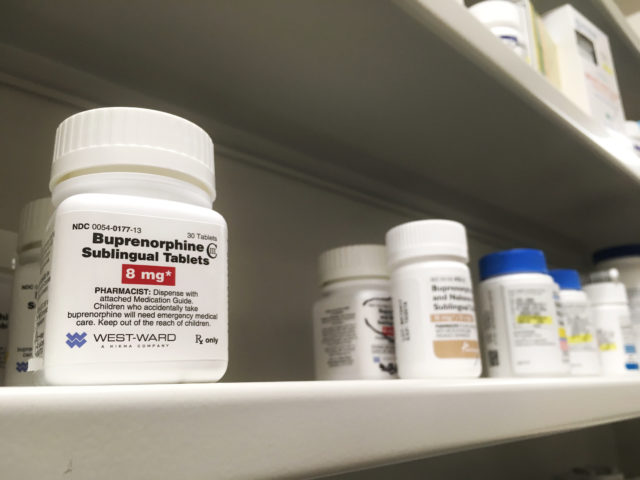
In September, Blue Cross Blue Shield of Tennessee, the largest health insurer in Tennessee, announced it would not cover oxycontin next year. Elsewhere, many health insurers are requiring prior authorizations to be completed for opioid prescriptions. Earlier this year the Centers for Medicare and Medicaid Services (CMS) had proposed a “hard” stop for opioid prescriptions of 90 Morphine Milligrams Equivalent (MME) for Medicare Part D plans. These policies and others by health insurers, hospital administrators, and state and federal regulators to tackle the opioid epidemic have largely been based on guidelines released by the Centers for Disease Control and Prevention (CDC) in March 2016.
As a physician I know firsthand the heartbreaking potential addiction has to ruin lives and tear families apart. The attention the opioid epidemic has received is absolutely warranted and leaders in the public and private sector should be commended for their efforts to fight opioid addiction. Yet, as a physician I also know the complexities and challenges that physicians face when treating chronic pain and it is imperative that medical guidelines, third party payer policies, and state and federal regulations reflect these complexities to best buck the trend of rising opioid-related overdoses and deaths, and minimize unintended consequences.
The Scope of the Problem
The prevalence of opioid use and abuse has increased substantially in recent years. Currently 3-4% of adults are on long-term opiate therapy and in 2012, 259 million prescriptions for opioids were written. As the use of opioids has increased so too have their serious side effects. From 1999 to 2013, deaths involving prescription painkillers quadrupled with more than 16,000 people dying from these medications in 2013. Between 1999 and 2014, over 165,000 individuals fatally succumbed to overdose from prescription painkillers. By 2002, opioids contributed to more deaths than heroin or cocaine.
Guidelines and Physicians
Generally speaking, physicians would benefit from additional training in the treatment of chronic pain, the risks of painkillers, and ways to mitigate the risks of opioids. The guidelines can help here. Medical schools, residency training programs, and academic medical centers must improve educational curricula on the treatment of chronic pain and opioid prescribing: alternatives to opioids, safety, and public health considerations should be prioritized. The guidelines can be a foundation for these efforts.
The CDC opioid guidelines were designed to be a tool for doctors treating patients with chronic pain. In fact, they state that their audience is “primary care clinicians (e.g., family physicians and internists) who are treating patients with chronic pain (i.e., pain lasting >3 months or past the time of normal tissue healing) in outpatient settings.” The CDC guidelines offer a resource for these physicians to facilitate important discussions with patients with chronic pain about the risks and benefits of opioids. The CDC guidelines also offer guidance on how patients on chronic opioid therapy should be monitored. In this context, they have the potential to help physicians better treat patients with chronic pain and could decrease the number of opioid prescriptions as well as the risk of these medicines.
The CDC opioid guidelines were not designed to be used by policymakers and regulators. Furthermore, they also state that they are intended to be “voluntary” and that “Clinical decision making should be based on a relationship between the clinician and patient, and an understanding of the patient’s clinical situation, functioning, and life context… and unique needs of each patient when providing care.” Unfortunately, the adoption by health insurers or governments at the state and federal level makes them mandatory, contradictory to their intent. It also hinders the ability of physicians to use their unparalleled education, training, and experience to best meet the “unique” situation of an individual patient and impedes the value of the patient-doctor relationship in medical decisions and limits shared decision making. This top-down approach to the opioid epidemic will limit choice. It also has the potential to produce an array of unintended consequences for patients, physicians, and the health care system, such as worsening pain, increased emergency room visits, increased health care costs, and restricted access. For physicians, it could lead to more paperwork, box checking, EMR clicks, professional dissatisfaction, physician burnout, physician retirement, and worsening of the primary care shortage.
Time Constraints and Treating Chronic Pain
The treatment of chronic pain is incredibly complex. Some of these nuances, limitations, and barriers are exclusive to chronic pain while others are more reflective of the health care system as a whole. Rather than drawing lines in the sand, policymakers, regulators, and administrators should craft policies and regulations that empower physicians to better treat their patients with chronic pain and create a health care system that better aligns with the spirit of the CDC opioid guidelines. Doctors and patients find themselves working in a system that works for the system. The current health care system does not align with the treatment of chronic pain or the mitigation of the risks of opioids. Doctors and patients need a health care system that works for doctors and patients.
The CDC opioid guidelines stress discussions with patients about the risks and benefits of opioids, education, and counseling. These are essential to the treatment of chronic pain but they are also time intensive and, unfortunately this is time that frontline providers often lack in today’s health care system. The time crunch stems from the physician reimbursement system that prioritizes quantity over quality and emphasizes procedures over cognition. The Physicians Foundation, in a 2016 survey of over 17,000 doctors, found that only 14% of doctors always had enough time to practice high-quality care. The survey found that almost 50% of physicians reported that their time with patients was always or often limited.
The time pressures of medical practice have been getting worse and are most significant for those with the most complicated medical and psychosocial needs. Research in the Journal of General Internal Medicine found the average primary care physician has a mere 3.8 minutes per clinical issue. In the trenches, the time is likely even less with physicians finding themselves devoting more time, resources, and energy to electronic medical records, an excessive amount of clicks, paperwork, and box-checking and less on actual patient care. These time pressures have produced a myriad of unintended consequences, including likely the over-prescription of opioids in the treatment of acute and chronic pain and limitations on the ability of physicians to mitigate the risks of opioids as well as recognize and treat addiction and opioid use disorder. While more peer-reviewed literature is needed to study the role that time constraints have played in fostering the opioid epidemic, a piece in the New England Journal of Medicine did highlight the reimbursement system and time pressures as impetus for opioid prescribing in the emergency room. Additionally, research in the Clinical Journal of Pain cited time constraints as a barrier to checking prescription drug monitoring programs (state data bases that are one of the main risk mitigation tools).
A More Patient-Centered Approach
To tackle the opioid epidemic, government payers should institute a more patient-centered reimbursement system that better meets the unique needs of individual patients and ensures patients get the time that their medical issues deserve. This would allow physicians to better treat their patients with chronic pain and do so as dictated by the CDC opioid guidelines. It would also allow physicians to better monitor risk profiles and mitigate the risk of those patients already on chronic opioids or that require chronic opioids in the future. This flexibility would be most helpful for those patients with the most complex medical comorbidities and greatest societal needs.
Simultaneously, CMS should work with the American Medical Association to make sure the recent changes in medicine, such as the adoption of EMRs and a transition to value-based care, are reflected by the RVS Update Committee (RUC) and cognition is adequately accounted for. The RUC assigns relative value to medical interventions and thus determines how much Medicare will pay physicians for their work. The RUC has been criticized for favoring procedures over cognitive interventions. Fixing this bias would help primary care physicians treat patients with chronic pain and better mitigate the risks of opioids when they are indicated.
The U.S. Department of Health and Human Services (HHS) should also adopt policies that encourage and support the use of technologies that better elevates the expertise of physicians to meet the needs of patient and improve the efficiency of physicians. At the same time, HHS should be careful about enacting policies that mandate health care technologies that do not improve physician efficiency and adopting mandates in general that are cumbersome for physicians. More broadly HHS needs to find a way to consider physician time in the regulatory process and consider and account for the impact its rules and regulations will have on physician time. This is incredibly important given the shortage of physicians in this country and time constraints of medical practice that already exist. In this work environment, these policies have the potential to take valuable physician time away from patients – time that could be used to treat diseases such as chronic pain.
The CDC opioid guidelines call for a collaborative approach to the management of pain. This integration and communication between providers is integral to the treatment of chronic pain and mitigation of the risks of opioids. Examples of this could include a primary care physician speaking with a surgeon about a recent procedure and how long the surgeon thinks the patient should require opioids for in the post-operative period. It could involve speaking with a psychiatrist about the mood and psychiatric medication regimen of a patient with chronic pain. It could also entail speaking with a pain management specialist about a patient’s case. These conversations and others could improve the management of a patient’s pain and facilitate the type of approach to pain as prescribed by the CDC opioid guidelines.
Unfortunately, historically, health insurers have not reimbursed for non-face to face care, which likely has deterred this type of coordination. To tackle the opioid epidemic and create a health care system that aligns with the CDC opioid guidelines, CMS should start reimbursing physicians for non-face to face work. This would encourage these important conversations and empower doctors to better treat chronic pain. It would also likely fuel innovation and produce a more patient-centered medical product and more patient-centered health care system. Research I authored in the American Journal of Medicine (Fodeman J, Factor P. Solutions to the Primary Care Physician Shortage. Am J Med. 2015;128:800–1) proposed three different ways for CMS to reimburse doctors for this work.
The Need for Regulatory Consistency
In recent years, physicians have found themselves subject to an onslaught of mandates and priorities. Some of these regulations pull physicians in competing directions with one mandate coming at the expense of the other. For example, some regulations mandate patient satisfaction, while others emphasize lowering healthcare costs. Yet, research in the Archives of Internal Medicine concluded that higher patient satisfaction correlated with higher healthcare expenditures. It was also associated with higher rates of death. CMS should work with the medical community to streamline and simplify these quality measures. CMS should also perform a comprehensive review to ensure consistency and eliminate competing priorities. Additionally HHS should ensure relevant regulations and statutes align with the CDC opioid guidelines.
Thus far the approach to the opioid epidemic has centered around incorporating the CDC opioid guidelines into policy, regulation, and statute. This top-down approach will limit choice and has the potential to maximize unintended consequences for patients, doctors, and health care systems. It is also not consistent with the original intent of these guidelines. A better approach for policymakers and regulators is to adopt solutions that facilitate a healthcare system that aligns with the CDC opioid guidelines. Leaders should attempt to understand the barriers, complexities, and limitations that providers face when treating patients with chronic pain and work with the medical community to espouse regulations and policies that better elevates the education, training and experience of physicians to treat patients with chronic pain.
Jason D. Fodeman, MD, MBA is a practicing primary care physician. He specializes in delivery systems and health policy.





